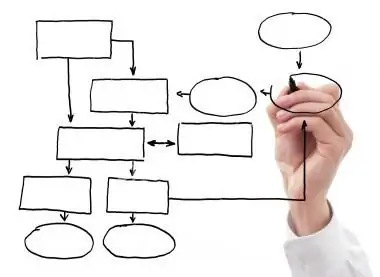2025 Author: Howard Calhoun | [email protected]. Last modified: 2025-06-01 07:12:56
With the advent of humanity, conflicts also appeared - situations where people have opposite views on solving the same problem. The clash of interests occurs in any sphere of human life: at work, at home, in transport, on the street, at school and other social places. Therefore, one must be able to realistically assess the conflict situation, see what it will bring - negative or positive, and resolve it in a timely manner.
Beginning of a conflict situation
Recently, much attention has been paid to the resolution of organizational conflicts, since too strained relations between employees can interfere with the normal development of the enterprise.
The conflict flares up gradually, and in order to extinguish it in time, you need to know the signs of its occurrence.
The following signs of conflict are distinguished:
- a situation appears, perceived by the participants as a conflict;
- the impossibility of dividing the subject of the conflict between the participants;
- desire to continue and develop the conflict situation.

There isseveral types of conflicts, among them - organizational conflicts that appear in the labor process between employees.
Types of conflicts
Disputes manifest themselves in different ways. To better resolve them, there is a classification of ongoing conflicts.
The following types of organizational conflicts are distinguished:
- Vertical - when a conflict situation occurs between management levels. Most often, this is the distribution of power, influence.
- Horizontal - at the level of people with the same status. Most often caused by a mismatch in goals, objectives and ways to solve them.
- Linear-functional - conflict between manager and specialists.
- Role-playing - the performance of roles does not match the expectations of a person. The number of tasks (roles) may be more than the employee is physically able to perform.
Conflict structure
The structure of organizational conflict consists of several elements combined into one integral system. It contains the subject and object of the conflict.
A subject is a real or imagined problem that causes disagreement between the parties to the conflict. That is what provokes the conflict itself. To get out of a conflict situation, you must clearly see the subject.
An object is what you want to get as a result of conflict resolution. It can be any object of the material, social or spiritual world.
Material values can be, for example, money, things, real estate, capital. Social - power, new status, promotionauthority, responsibility. Spiritual include ideas, principles, norms.

Conflicts occur in any organization, without them the creative process is impossible. If the team exists in conflict-free situations, this may mean that nothing new is happening here: new ideas are not generated, there is no initiative, and in a competitive environment this can be disastrous.
What causes conflict?
The appearance of a dispute is preceded by the appearance of the subject of the dispute.
Causes of organizational conflicts can be divided into two groups:
- interpersonal relationships in the organization;
- dissatisfaction with the structure, functionality, structure of the organization.
When a person gets a job, he enters into relationships with people new to him. Being at the workplace and performing their duties, the employee may feel dissatisfaction with the circumstances surrounding him, which will result in an organizational conflict.

Conflict situations cause such problems:
- lack of resources to carry out their duties;
- dissatisfaction with the internal structure of the organization;
- profit of workers depends on the amount of work performed, while there is competition between them;
- role conflict;
- changes in the organization: technical, organizational and others;
- the duties of the employee do not clearly indicate for what and what kind ofresponsibility.
Conflict situations
Let's take a closer look at the causes of organizational conflicts.
Insufficient resources to carry out their duties. Performing duties at his workplace, a person wants to receive the full amount of resources he needs for this. At the same time, the distribution of resources usually comes from the maximum need of the employee, so everyone tries to show that they are more important to him now, that his work is more significant for the enterprise and will bring more benefits. In this regard, organizational conflicts flare up
Dissatisfaction with the internal structure of the organization. Every organization has a structure. In carrying out their functions, departments form a relationship. At the same time, everyone tries to get the maximum benefit for their unit. For example, you need to hire a new employee, and the finance department cuts the budget. This will result in a contentious situation between HR and Finance

The profit of workers depends on the amount of work performed, while there is competition between them. This problem is relevant for organizations in which the employee's salary depends on the implementation of the plan (for example, an insurance plan, sales). In such cases, each employee tries to "drag" customers to himself in order to make a big profit. Organizational relationships become strained, resulting in conflict
Role conflict. Each employee performs his role in the enterprise, expects the fulfillment of dutiesand from other employees. However, their views on each other's roles may not coincide
Changes in the organization: technical, organizational and others. A person is wary of any changes, especially if they occur in the workplace. An employee who has a long record of work will perceive novelties at work with distrust, it is more familiar and easier for him to work according to the old rules. Therefore, if the management wishes to change the old way of life, improve the material and technical base, this may result in a protest of workers

The duties of an employee do not clearly state what and for what he is responsible. If people within the organization do not clearly know how responsibility is distributed, then when unpleasant situations arise, they will shift the blame on each other. Therefore, a good manager must clearly list the responsibilities of each employee and assign them responsibility for specific situations
Interpersonal causes of conflict
The team of any organization consists of people with different temperaments, outlooks on life, habits. Therefore, being in close and constant contact with each other, employees enter into interpersonal conflicts.
Causes of organizational conflicts:
Prejudice. There are situations when two people treat each other unfairly because of personal antipathy, even though this has nothing to do with the labor process. If one of them has more power (the boss), then he canunfairly reduce wages or apply pen alties to a subordinate. In this case, the relationship between them will constantly be in a state of conflict
Violation of territory. While working, a person gets used to his workplace, environment, department. And situations when an employee is decided to be transferred to another department can cause irritation on the part of the employee, unwillingness to change the situation and the usual team

There is a person in the organization who simply provokes conflicts. There are people who, by their relationship to others, seem to attract conflicts on purpose. The reason may lie in their inflated self-esteem and the desire to show that they are the most worthy
Four common groups of conflicts
Organizational and managerial causes of conflicts are related to the functionality of the organization. There are four general groups for the development of conflict situations:
- Structural and organizational.
- Functional-organizational.
- Personal-functional.
- Situational management.
The first kind of causes occurs when the structure of the organization does not match the tasks performed. Ideally, it should be developed for the tasks that the institution will be engaged in. If the structure is designed incorrectly and does not correspond to the tasks performed, then a structural-organizational conflict develops in the team.
It is necessary to approach the creation of the structure of the organization carefully, especially if the company is constantly changingfield of activity. This should be considered.
Functional and organizational reasons appear when the organization's ties with the external environment are disrupted, disagreements between departments, employees.
If the qualifications of an employee do not meet the requirements of his position or the performance of work duties does not meet his moral standards, personal qualities, then this will cause a conflict with personal-functional reasons.
Situational and managerial causes of conflicts appear when managers or subordinates make mistakes when performing work tasks. If the management decision was initially made with an error, then it will not be possible to execute it correctly. This will provoke a conflict between the employees who performed it. Organizational and managerial conflict can occur when setting unrealistic goals.
Types of conflict resolution
Methods that resolve organizational conflicts can be grouped into three groups:
- One-sided - one side overwhelms the other.
- Compromise - each side makes concessions, and they stop at the moment when the decision satisfies both.
- Integrative - the problem is solved by a new developed version. At the same time, each of the parties considers this invention their own.
At the same time, only the third method is able to completely resolve the controversial situation. In the first two groups, the conflict will remain the same, just to a lesser extent.
Ways out of conflict situations
Organizational conflict management can be done withby creating situations like this:
Transferring conflict to an interpersonal level. This practice makes it easier to resolve the conflict. In practice, it looks like this: small groups are formed, with approximately the same number of participants in the conflict. Psychologists begin to cooperate with them. Using various techniques, psychologists invite participants to consider what conflict will bring more to the development of the enterprise: positive or negative. Is the subject of the dispute so important as to cause a conflict? Specialists also conduct various exercises from social trainings, such as role exchange; learn to self-reflect. This allows you to calm and relax employees, make them reconsider their views on the conflict situation

However, the complexity of this method lies in the fact that when the groups return to their jobs, they can succumb to the majority and again become embroiled in conflict.
Appeal to the periphery of the conflict. This is an appeal to the participants who are less involved in the conflict situation. Under the influence of the majority of employees who are not involved in the dispute, the conflict will begin to die out on its own, since it will not receive new "outbreaks"
Legal mechanisms of solution. Conflicts are resolved with the help of legal mechanisms: official orders, orders, resolutions
Organizational methods. These include: change of leader, identification of informal leaders
Chat with employees
To prevent organizational conflicts of the organization, it is necessary to periodicallyconduct a survey of employees, find out what they lack to perform their duties, what new they can offer to improve the functionality of the enterprise. Polls will be especially relevant for upcoming innovations.
If an emergency situation has occurred in an organization, there is no time to resolve the conflict and an urgent decision needs to be made, then you can use the force method - to introduce a management decision that the manager considers necessary. However, this should not be abused, as disputes will arise between employees and the manager.
Conclusion
Because conflicts appeared with humanity, they have become an integral part of social life. Organizational conflicts can either improve the organization's activities, for example, by generating new ideas, improving the workflow, or suspend its development due to a high degree of conflict in the team: employees will only be busy solving their problems and will ignore production issues.
Therefore, the management of companies should be able to timely and correctly resolve organizational conflicts. A correctly found path to resolving a disputable situation will bring new development paths and ideas to the organization, while maintaining a friendly team.
Recommended:
Conflicts in a team: ways to resolve them, classification, causes and effective methods for solving problems

The problem of conflicts in the team and ways to resolve them is relevant for people involved in various fields and areas. A specific feature of a person is the complexity of interaction with other persons under certain conditions. The larger the team, the higher the likelihood of conditions that are followed by tense conflict relations. Let's consider this topic in more detail
Conflicts in organizations are The concept, types, causes, methods of solving and consequences of conflicts in an organization

Misunderstandings accompany us everywhere, we often encounter them at work and at home, in communication with friends and acquaintances. Conflicts in organizations deserve special attention - this is the scourge of many companies, which include a large number of employees. In some cases, such clashes of interest can be seen as an additional part of the work process aimed at improving the climate in the team
Organizational structures of an enterprise - an example. Characteristics of the organizational structure of the enterprise

The implementation of plans and programs is achieved by building an organizational structure that allows you to effectively organize the joint activities of staff through the appropriate distribution of duties, rights and responsibilities. The article highlights the elements of the organizational structure, gives examples of its various types, highlights their advantages and disadvantages
What is the project structure? Organizational structure of the project. Organizational structures of project management

The project structure is an important tool that allows you to divide the entire course of work into separate elements, which will greatly simplify it
Examples of professional conflicts and their resolution. Types of professional conflicts

Social science teaches that any social relationship involves conflict. This is how the world works: what is good for a Russian is death for a German. On the basis of mismatch of expectations, goals and interests, disagreements and conflicts arise. How to get out of such situations with minimal losses? Is conflict always bad?

